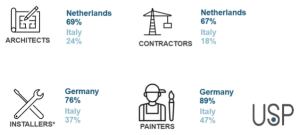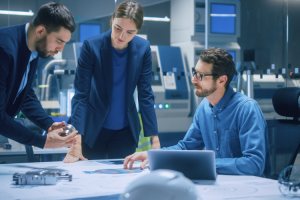


Market report
Labour shortage in Construction Industry?
Gain valuable insights into the European architectural market through the European Architectural Barometer report provided by USP Marketing Consultancy. Learn more about the trends and opportunities impacting architects in this region.
Blogs I published 19 April 2024 I Dirk Hoogenboom
How To Combat Labour Shortage In The Construction Industry?
In the European construction and installation market, labour shortage issues are quite severe and responsible for higher costs of construction due to increasing labour prices.
Personally, I think that labour shortage is one of the most important ‘trends’ in the industry. However, it’s typically overshadowed by other trends like sustainability, AI, Prefabrication, digitalisation in general and so on.
Labour shortages are currently already quite severe. For example, about half of all European architects are hindered by shortages in the execution of their projects. It’s the highest in Netherlands with almost 7 out of 10 architects facing this issue. Amongst European contractors, the numbers are roughly the same. Amongst HVAC installers the problems are even more severe, with about 60% stating that labour shortages are severely hindering their capacity to take on and carry out projects. German installers face the biggest problems, with roughly three quarters of the installers facing these problems. Last but not least, labour shortages seem to be the highest amongst painters, with a whopping 9 out of 10 German painters stating that they are faced with strong labour shortage challenges.


Image 1. Share of stakeholders who experience labour shortage
So why are the problems so severe? In the first place, multiple industries are struggling with labour shortage issues, but the construction industry is hit particularly hard due to the fact that working in construction is, in general, not seen as an attractive profession. This means that, especially in times with low unemployment, the construction industry will struggle to compete for the available labour force.
Furthermore, because it is typically a labour intensive industry requiring a lot if manual labour, the retirement age is typically also lower (at least for on the jobsite work)
In Europe, there is an additional element that negatively effects the availability of labour, which is the ‘aging’ or ‘silver society’ in Europe. As the make-up of the demographic pyramid in Europe is more top heavy (meaning more older generations vs younger’ the inflow is lower then the outflow.
Keeping with the relatively old population in Europe, this not only increases the quantitative labour shortage, but also increases the qualitative labour shortages. The younger generations flowing into the construction industry are far less experienced then the older generations that flow out.
Speaking of age build up, if we look for example at painters, 24% of the total population in Europe are baby boomers, 54% is generation X and only 21% is Generation Y. This means there will be a significant outflow of workers in the upcoming decade, without enough new workers coming in. In some countries this is even more extreme. For example in the UK, 44% (!) of all painters are of the baby boom generation, 40% generation X and only 16% is generation Y.
So we established that labour shortage problems are already severe and will increase in the upcoming decade, unless something significantly changes.
So how can we combat labour shortage in the construction industry? Well, there are 2 possible routes.
First of all, we could try to increase the labour component. This can, for example, be achieved by making the profession of working in the construction industry more attractive. In many countries, like for example in the Netherlands, extensive PR campaigns have been launched to try to attract more people for the construction industry. Unfortunately, up until now, the effects are limited at best. It needs to be done, but it won’t result in a significant change. Or at least not significant enough to change the course we are currently on. On top of that, this would require an integrated industry effort.
We could also try to attract workers from other industries to get them reschooled. However, with the tense labour market in Europe the success rate of this will also be limited. Bringing in more workers from outside the EU could be an option, but given the current political situation and the lower availability of qualified foreign workers, this might also not be the solution to change the negative trend of labour shortages.
The other possible solution would be to increase, significantly, the productivity levels in the construction industry. However, when looking at the development of the productivity levels in the construction industry in last decade, especially compared to other industries, it hasn’t increased significantly. Even with the strong development of prefab and manufacturers trying to produce more ‘easy to build’ products and solutions, productivity levels almost didn’t increase or at least not significantly.
The reason for this? Well when it comes to prefabrication, it’s typically done off-site in an on-site manner. Meaning, that the work remains more or less the same (with the same labour needs), but is just done off-site. This leads to limited productivity gains. Furthermore, a large part of the market builds in a very traditional way, without prefab applications. On top of that, a large part of the market is driven by renovation, where prefabrication plays no role.
As for the ‘easy-to-install’ products, big steps have been made. However, the products/projects themselves become more complex, mitigating for a large part the gains made by more easy to instal products. An example I like to use are wall mounted gas boiler versus heat pumps. A knowledgeable installer can instal 2 gas boilers per day. However a single heat pump installation can take upwards of 2 to 3 days, depending on how much other adjustments need to be made to the heating system.
In order to combat labour shortage in the construction industry, improvements need to be made in the use of prefabrication and the improvements in easy to install products.
If we start with prefabrication, this means that this needs to be more industrialised. Just like Henry Ford transformed the automotive industry with the model T ford. Now this is already happening in the construction industry, with complete houses, bathroom pods, installations being build in an industrialised manner with, in many cases, the usage of robotics. However, the volume produced is not significant enough yet to offset the labour shortage short to midterm. Long term, this development can, at least for new build, increase the labour productivity significantly.
This development, combined with a further evolution of ‘plug and play’ products and solutions, would be the best bet to off set the labour shortages in the future. Again, this would be a mid to long term fix.
There are of course other solutions to increase labour productivity. For example digitalisation, like BIM, can ensure a smoother and faster building process, with less mistakes and thus failure costs, which typically also mean lost labour productivity. Furthermore, developments like 3D printing & robotics can have a significant impact on the productivity levels. However, due to the conservative nature of the industry and the fact that the majority of buildings are still constructed in an traditional manner, means that the adoption speed is relatively low (excluding perhaps BIM). Furthermore, the technology needs to developed much further before we will see a significant increase in the adoption rate. So this is also a remedy for the mid to long term.
And finally, for all of the solutions to combat labour shortage in the construction industry, we need to bear in mind that a significant size of the market that is related to renovation. In the renovation market most of the solutions mentioned will have a limited or non-existing impact on reducing labour shortage.
To conclude, labour shortage is already a severe problem and will only increase in the upcoming years due to demographics. Mid to long term solutions like prefabrication, plug and play products, digitalisation and robotisation have the potential to increase the labour productivity levels for new build significantly and thus reduce the labour shortages to a degree. In the renovation market, it will be much harder to gain more productivity. Short term, in my opinion, there is no direct solution to the labour shortage issues. But mid to long term, with the adoption of new technologies and products, we might be able to reduce the impact of labour shortages.

Read more

Fresh Insights Await
Our relevant reports
Delve into the newest findings across various market segments, crafted for a cutting-edge overview. Explore our insightful reports, brimming with up-to-date data, trend analyses, and in-depth examinations, all tailored to provide you with a comprehensive understanding of the current market dynamics.
Construction
Home Improvement
Installation
Special reports












